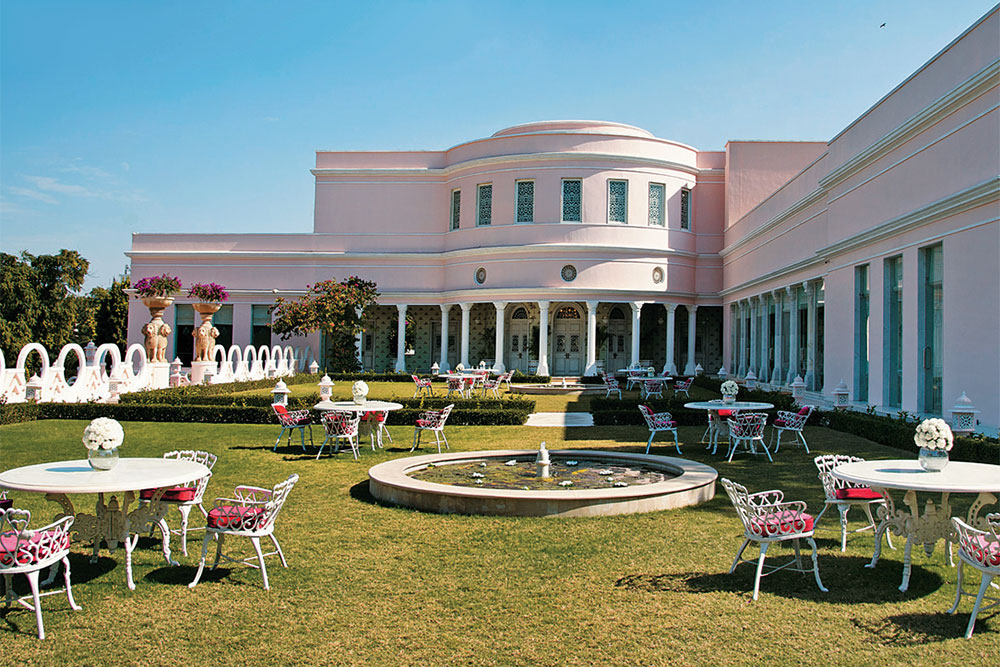She’s charming and unassuming, all at once. The few times I’ve had the pleasure of meeting Princess Diya Kumari, daughter of the late Maharaja of Jaipur, Brigadier Sawai Bhawani Singh Bahadur, she’s always looked every inch the royal Rajasthani princess, with her impeccable chiffons that reflect the juicy, vibrant hues of her home state. Her manner is gracious, and completely unaffected. Her tone, when she speaks, is forthright, no-nonsense. Perfectly suited to her present role as an elected member of the Rajasthan Legislative Assembly from her constituency of Sawai Madhopur, and somewhat akin to her grandmother, the late Maharani Gayatri Devi, with whom she spent many a precious day growing up.
As the Maharaja’s only child, the 40-something princess and mother of three today single-handedly spearheads the incredible legacy of the Jaipur royal family, a legacy that seeps into her work as a trustee of the Maharaja Sawai Man Singh II Museum, of the women-empowering Princess Diya Kumari Foundation, and her outlook on life. “It’s a great responsibility and a matter of great pride, with lots of expectations,” she says. The princess says she learnt to balance the various aspects of her busy life, from her father. “He enjoyed the luxuries of life; he was a polo player; he enjoyed travelling; he loved good food. But he taught me to never let anything go to my head, and remain humble.”
And she’s continued to cement the legacy that her father set in motion, such as the Museum and the family’s various palaces-turned-hotels that dot the city. One of the most striking renovations has been the brand new exhibition gallery at the Sawai Man Singh II Museum, at the City Palace, that showcases paintings and photographs from the Museum’s collection, many hitherto unseen. “We had the Eka team headed by Pramod KG, and Giles Tillotson, our inhouse director of research, do a lot of the work,” says Diya Kumari.
She’s also been instrumental in revamping the Sculpture Lumiere Show, a unique offering for visitors who can enjoy a spectacular display of light and sound by French artist Patrick Rimoux with the voice of Amitabh Bachchan. “People want to know, what is the family up to, these days?” says Diya Kumari of the show that highlights the epoch from Sawai Jai Singh until now. “Jai Garh palace also has a new gallery, dedicated to war memorabilia from my father and grandfather’s time, and the medals they were awarded.” Her love of textiles has seen her set up the famous 36 karkhanas, that have revived dying Jaipur crafts, and made it saleable to visitors.
And when she’s making those frequent trips to her constituency as a member of the RLA, she’s also keeping an eye on her Princess Diya Kumari Foundation, which trains and allows women from a lower socio-economic background to gain skills and sell their wares to exporters and retailers. “I now have 300 women in Sawai Madhopur, who already have a skill; it could be cooking, sewing, embroidery; we train them via workshops, and they end up earning ₹2,000-3,000 a month.”
Asked if at all her royal lineage has made her life in politics any easier, she’s quick to comment: “Politics is different to everything else; it’s a full-time job, and thankless at most times. But the respect and love from the public comes easy, because people still feel that the erstwhile royal families looked after their people very well. In those days, hatred among castes and religion didn’t exist, nor did corruption. There was more peace and prosperity, in a way.”
So to return to the princely life, one wonders which is her favourite palace in the entire city of Jaipur. “Rajmahal, which we’ve recently renovated,” she says. “It’s an amazing property, and we’ve restored it beautifully. I would call it one of the only boutique hotels of Rajasthan.” A visit to Rajmahal, now managed by the Sujan Luxury group, reveals a pink art deco wonder done up in brilliant jewel tones and pastel blues, strewn with silver frames of the late Maharani Gayatri Devi and Maharaja Sawai Man Singh II, Princess Diya’s grandfather.
As a child, the princess was privy to many a grand ceremony, such as Holi with her family, and in recent times, she counts the official tilak ceremony of her son, the teenage Maharaja of Jaipur, Padmanabh Singh, an emerging polo player and student at Millfield School, UK (who was recently appointed brand ambassador of fashion brand La Martina), as one of her favourite moments. The princess loves to travel, and particularly enjoys New York City, Italy, Monaco, and England to visit her son. “As a child I loved going to Disneyworld with my parents, now I enjoy taking my children there,” she says.
Along the way, she’s met a few striking personalities. “I was just 19 when Princess Diana visited India,” she says. “She made a huge impact because she was so beautiful; the way she spoke, the way she was, we all looked up to her.” She’s also enjoyed meeting “larger-than-life” former US President Bill Clinton, and the “amazing” Oprah Winfrey.
As for that impeccable fashion quotient, Diya Kumari admits that she “hasn’t gone to a designer in years”. But when asked further, she admits having a fondness for the leheriyas, bandhnis, and shaded chiffons of the nationally acclaimed Tayeb Khan from Jodhpur. Like all women, the princess loves shopping for bags and shoes, but doesn’t divulge any passion for collecting any valued items, unlike her mother Rajmata Padmini Devi.
Princess Diya Kumari, ever the doyenne of her family’s legacy, is keen that her children preserve it and carry it forward after her. “I tell them to be good people, to be compassionate, to have time for their loved ones,” she says. “I want all three to be there for each other, always.” And how would she like to be remembered? “As someone who was a good human being, a good mother, who was there for people.” Spoken like a true princess.












 Just one email a week
Just one email a week